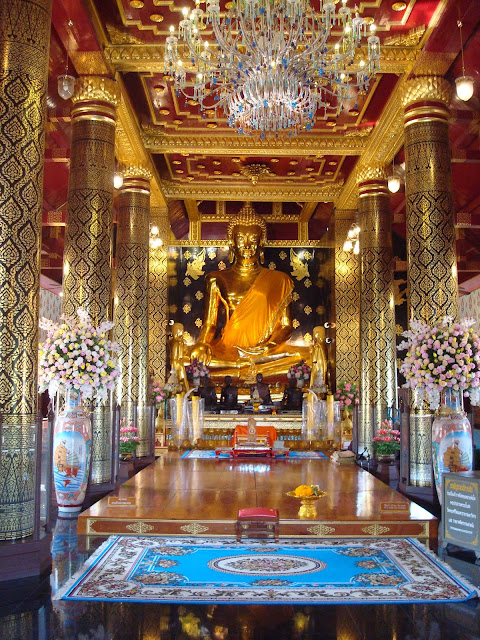29. The Most Beautiful Temple in Thailand?
Chances are, you've never heard of the town of Phitsanulok. Odds are even greater that you can't pronounce it's name. And, if you've ever been there, it was probably just to break up the 12-hour train ride from Bangkok to Chiang Mai; or, as a base for exploring the nearby ruins of Sukhothai, one of Thailand's (many) ancient capitals.
That's unfortunate, because Phitsanulok houses several beautiful and important historical sites of its own - not the least of which is the magnificent and sprawling Wat Phra Sri Rattana Mahatat Woramahawihan. And no, I can't say it five times quickly or pronounce it correctly even once. I just do what the locals do and call it Wat Yai (Big Temple).
Wat Yai was built in 1357, with numerous renovations since. Its most important Buddha figure, the Phra Phuttha Chinnarat (Victorious King) is considered to be the most beautiful in Thailand. It's also regarded as the second-most important, out-venerated only by the emerald Buddha (which is actually made of jade and really small) in Bangkok.

The Buddha's beauty is said to spring from the halo that surrounds its body, radiating holiness. The statue was originally cast in bronze but later plated in gold, giving it an extraordinarily bright sheen.
For those who envision Buddhist temples as retreats of near silence and peaceful contemplation, Wat Yai should cure that illusion. Just past the entry to the compound, you'll be confronted by a cacophony of sounds - amplified broadcasts asking for donations, a strip of vendors hawking everything from herbs to temple offerings, lottery tickets and framed posters of the Buddha.
Past the hubbub is the entrance to the main sanctuary. It was smaller than I had imagined, but extremely ornate:
Inside, the sanctuary proved to be somewhat of a Tardis. The hall was quite deep:
And also high, with pillars and ceiling adorned in gold and lit by crystal chandeliers:
Amazingly, this was just one of a number of sanctuaries dotting the Wat Yai compound. Behind it was another featuring gloriously framed doors and windows:
another imposing Buddha:
and a set of paintings that told the story of King Naresuan the Great who, in the 15th century, personally led his army on elephant back to free central Thailand from Burmese rule:
For me, the most fascinating part of Wat Yai was the cloisters, now serving as a display area for ancient Buddhas:
There were lots and lots of Buddhas:
Big Buddhas:
Small Buddhas:
And just outside the cloisters (probably because he couldn't fit in), this unusually chunky Buddha:
Wat Yai offered many WOW moments, but one thing that really surprised was the way people dressed. Having travelled through many Buddhist countries over the course of 27 years, I was well aware of the advisories, admonitions and strictures requiring visitors to dress respectfully, i.e. arms and legs covered. Apparently the locals weren't quite so aware. Many wore short-shorts, tank tops, muscle shirts, t-shirts, miniskirts, flip-flops etc. Guess they hadn't read the same guide books.
That's unfortunate, because Phitsanulok houses several beautiful and important historical sites of its own - not the least of which is the magnificent and sprawling Wat Phra Sri Rattana Mahatat Woramahawihan. And no, I can't say it five times quickly or pronounce it correctly even once. I just do what the locals do and call it Wat Yai (Big Temple).
Wat Yai was built in 1357, with numerous renovations since. Its most important Buddha figure, the Phra Phuttha Chinnarat (Victorious King) is considered to be the most beautiful in Thailand. It's also regarded as the second-most important, out-venerated only by the emerald Buddha (which is actually made of jade and really small) in Bangkok.

The Buddha's beauty is said to spring from the halo that surrounds its body, radiating holiness. The statue was originally cast in bronze but later plated in gold, giving it an extraordinarily bright sheen.
For those who envision Buddhist temples as retreats of near silence and peaceful contemplation, Wat Yai should cure that illusion. Just past the entry to the compound, you'll be confronted by a cacophony of sounds - amplified broadcasts asking for donations, a strip of vendors hawking everything from herbs to temple offerings, lottery tickets and framed posters of the Buddha.
Past the hubbub is the entrance to the main sanctuary. It was smaller than I had imagined, but extremely ornate:
Inside, the sanctuary proved to be somewhat of a Tardis. The hall was quite deep:
And also high, with pillars and ceiling adorned in gold and lit by crystal chandeliers:
Amazingly, this was just one of a number of sanctuaries dotting the Wat Yai compound. Behind it was another featuring gloriously framed doors and windows:
another imposing Buddha:
and a set of paintings that told the story of King Naresuan the Great who, in the 15th century, personally led his army on elephant back to free central Thailand from Burmese rule:
There were lots and lots of Buddhas:
Big Buddhas:
Small Buddhas:
And just outside the cloisters (probably because he couldn't fit in), this unusually chunky Buddha:
Wat Yai offered many WOW moments, but one thing that really surprised was the way people dressed. Having travelled through many Buddhist countries over the course of 27 years, I was well aware of the advisories, admonitions and strictures requiring visitors to dress respectfully, i.e. arms and legs covered. Apparently the locals weren't quite so aware. Many wore short-shorts, tank tops, muscle shirts, t-shirts, miniskirts, flip-flops etc. Guess they hadn't read the same guide books.














No comments:
Post a Comment